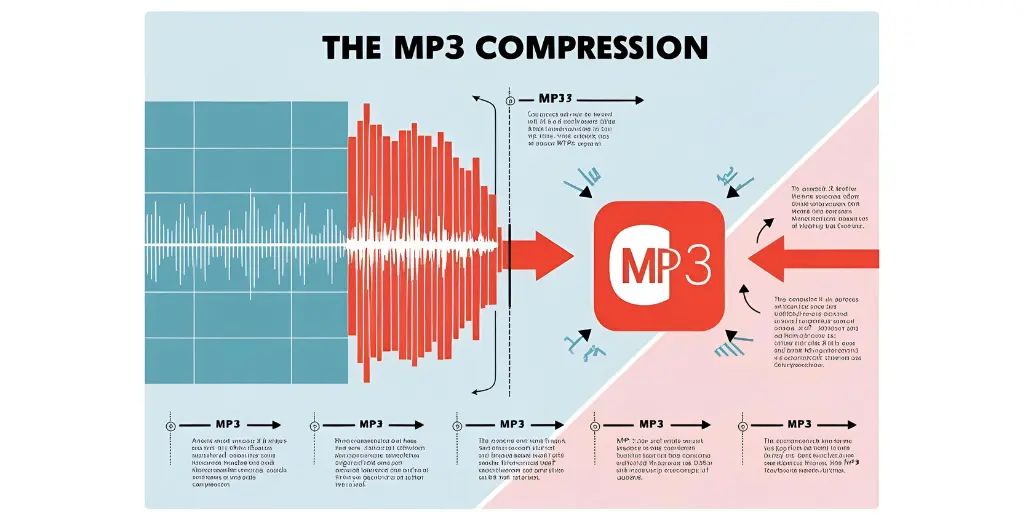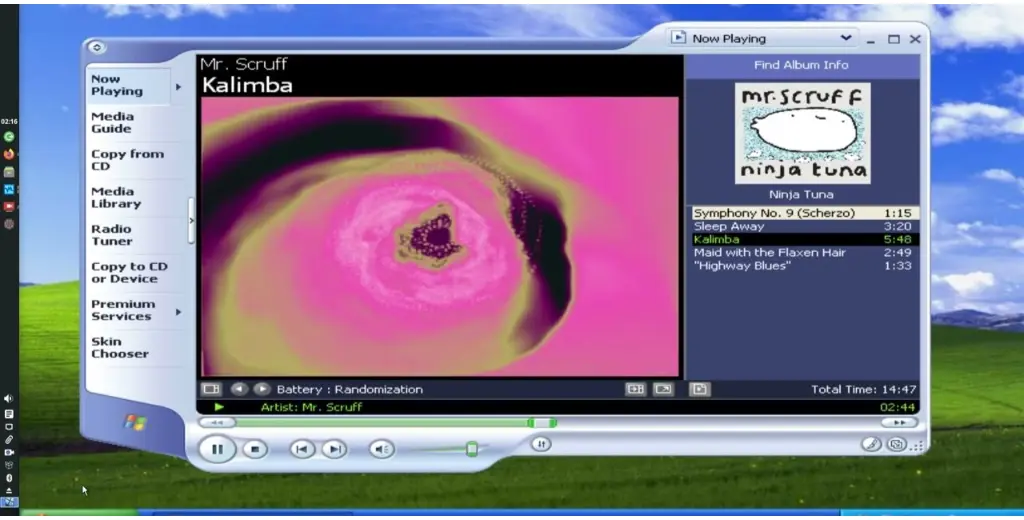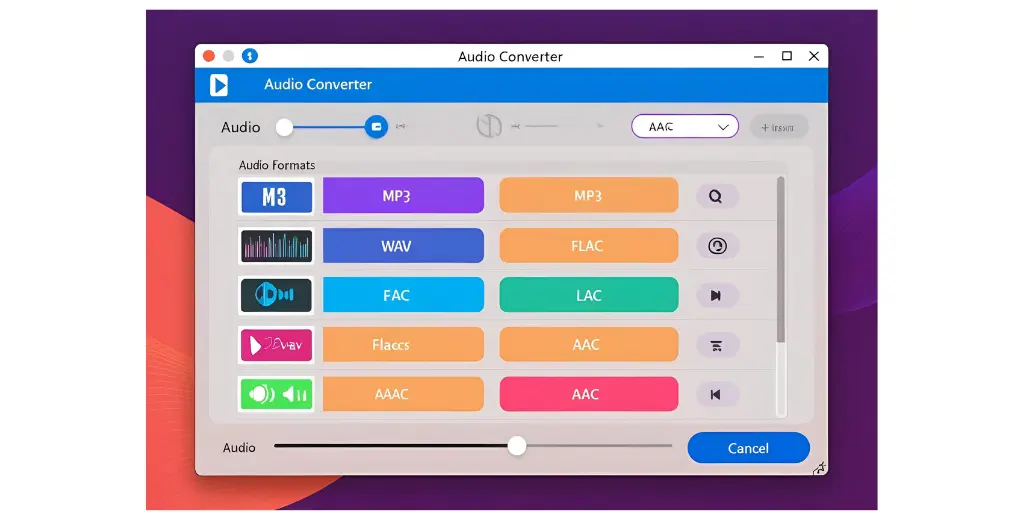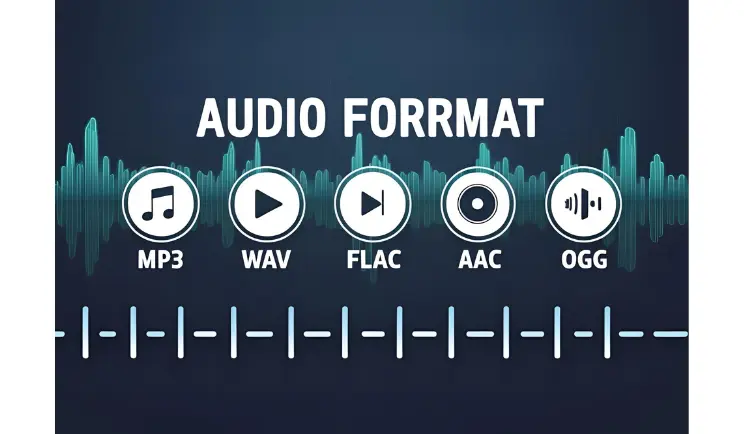Ever wondered what’s behind the music or podcasts you listen to every day? Audio formats are the unsung heroes making it all happen. They’re like the recipes for how sound gets packed into files—some keep every detail, some shrink things down. Whether you’re jamming on your phone or tweaking tracks on a laptop, these formats shape what you hear. Let’s dig in and unpack what audio formats are all about, keeping it simple and real.
Table of Contents
What’s an Audio Format Anyway?
An audio format is just a way to store sound digitally. Think of it like a container—inside, it holds the audio data, whether it’s a song, a voice memo, or a movie soundtrack. The format decides how that sound is saved, played, and shared. Some squeeze the file to save space; others keep it raw for top-notch quality. You’ve probably seen names like MP3 or WAV—those are audio formats, each with its own vibe.
Why So Many Formats?
You don’t cook every dish the same way, right? Same deal with audio. Different formats exist because people need different things—portability, quality, or compatibility. Back in the old days, like when Android 2.2 Froyo phones were big, storage was tight, so formats had to slim down. Now, with more space and better tech, we’ve got options for every situation. It’s all about balancing size, sound, and what your device can handle.
MP3: The King of Compression
MP3 is the name everyone knows. Short for MPEG-1 Audio Layer 3, it hit the scene in the ‘90s and changed everything. It shrinks audio files by tossing out bits of sound humans don’t notice much—like super high frequencies. A song that’s 50MB as a raw file might drop to 5MB as an MP3. It’s why your old Android 4.4 KitKat phone could hold hundreds of tracks. Downside? You lose some detail, but it’s still the go-to for casual listening.

WAV: Raw and Unfiltered
WAV, or Waveform Audio File Format, is the opposite of MP3. It’s uncompressed—keeps every little sound wave exactly as recorded. That means awesome quality, but huge files. A three-minute song could easily be 30-40MB. Studios love WAV for recording because it’s pure, but it’s not practical for your phone unless you’ve got tons of space. Older versions of editing software leaned on WAV hard—it’s a classic that’s stuck around.
AAC: MP3’s Smarter Cousin
AAC stands for Advanced Audio Coding. It’s like MP3 but better—smaller files with clearer sound. Apple pushed it big with iTunes, and Android picked it up too. It cuts out more noise humans can’t hear, so you get quality close to a CD in less space. A lot of streaming apps use AAC because it’s efficient. If you’ve got a newer phone, chances are it handles AAC smoother than older versions from the Android 5.0 Lollipop days.
FLAC: Lossless for Audiophiles
FLAC—Free Lossless Audio Codec—is a dream for sound nerds. It compresses files without losing a single detail, unlike MP3 or AAC. You get CD-quality audio at about half the size of WAV—say, 20MB for that same three-minute track. It’s perfect if you’ve got high-end headphones and hate compromise. Older FLAC versions needed beefy devices to play, but now even mid-range Androids handle it fine. It’s a win for quality freaks.

OGG Vorbis: The Open-Source Star
OGG Vorbis is a bit of an underdog. It’s free, open-source, and doesn’t skimp on sound. Like MP3 and AAC, it’s lossy—throws out some data—but it’s smarter about what it keeps. You get better quality at lower file sizes than MP3, which made it a hit with tech geeks. Some old Android games used OGG for soundtracks because it was light and punchy. It’s still around, though not as mainstream.
ALAC: Apple’s Lossless Pick
ALAC, or Apple Lossless Audio Codec, is FLAC’s cousin but made by Apple. It’s lossless too—keeps all the audio goodness—but works best in Apple’s world. Android can play it with the right apps, though it’s not native like AAC. Files are big, but smaller than WAV. It’s less common on Android, especially on older versions like Android 6.0 Marshmallow, where support was spotty unless you tweaked things.
WMA: Windows’ Old Player
WMA—Windows Media Audio—came from Microsoft way back. It’s lossy like MP3 but was big in the Windows XP era. It promised smaller files and decent sound, but it never took off on Android. Older versions of Windows Media Player loved it, and some folks still have WMA files from those days. You can play it on modern phones with a converter, but it’s mostly a relic now.

How Formats Affect Quality
Here’s the deal—quality depends on compression. Lossy formats (MP3, AAC, OGG) ditch some sound to save space, so you might miss tiny details—like a faint cymbal in the background. Lossless ones (FLAC, ALAC, WAV) keep it all, perfect for picky ears or big speakers. Bitrate matters too—128kbps MP3 sounds okay, but 320kbps is richer. Older Android versions struggled with high-bitrate files, but today’s phones chew through anything.
File Size vs. Storage
Size is a huge factor. A WAV file might eat 50MB for one song, while an MP3 of the same track is 5MB. Back when phones had 4GB of storage—like Android 3.0 Honeycomb days—you couldn’t mess with big formats. Now, with 128GB or more, FLAC’s fair game. Still, if you’re downloading tons of audio, lossy formats save the day. It’s why apps like VidMate let you pick formats—space or quality, your call.
Compatibility Across Devices
Not every format plays nice everywhere. MP3 works on anything—your phone, car stereo, ancient MP3 player. WAV and FLAC? Most modern Androids handle them, but older versions might choke without extra apps. AAC’s good on newer systems, less so on early Androids like 2.3 Gingerbread. Check what your gear supports before you stock up on files—nothing’s worse than a song that won’t play.
Picking the Right Format
So which one’s best? Depends on you. Casual listener with cheap earbuds? MP3 or AAC’s plenty. Got a fancy setup and care about every note? FLAC or WAV’s your jam. Tight on space? OGG or AAC keeps it small. Older Android versions might nudge you toward lighter formats—newer ones give you room to play. It’s all about what you’re hearing and how much you’re willing to store.
Converting Between Formats
Stuck with the wrong format? No sweat—converters fix that. Apps or desktop tools can flip an MP3 to FLAC, WAV to AAC, whatever you need. Quality won’t improve—lossy to lossless doesn’t bring back what’s gone—but it’s handy for compatibility. Older versions of these tools were clunky, but now it’s a breeze. Just don’t expect a 128kbps MP3 to sound like a CD after converting.

Why It’s Worth Knowing
Understanding audio formats isn’t just geek talk—it’s practical. You’ll know why your playlist sounds flat or why your phone’s storage is full. It helps you pick what works—whether you’re ripping CDs, downloading tracks, or streaming. Plus, as Android keeps evolving, newer formats might pop up, and you’ll be ready. It’s like knowing your car’s engine—makes the ride smoother.
What’s Next for Audio?
Audio formats aren’t standing still. New codecs keep shrinking files while boosting sound—think hi-res audio for less space. Older formats like WMA might fade, but MP3’s sticking around for its universal vibe. Android’s support keeps growing too—future versions could handle wilder formats we haven’t even heard yet. For now, you’ve got plenty to play with, old and new.

